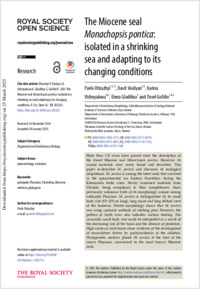The Miocene seal Monachopsis pontica: isolated in a shrinking sea and adapting to its changing conditions
DOKPE
- Otriazhyi, Pavlo ORCID University of Fribourg
- Vasilyan, Davit ORCID University of Fribourg
- Vishnyakova, Karina ORCID Ukrainian Scientific Centre of Ecology of the Sea, Odesa, Ukraine
- Gladilina, Elena ORCID BioEcoLinks NGO, Lymanka, Odesa, Ukraine
- Gol’din, Pavel ORCID National Academy of Sciences of Ukraine, Kyiv, Ukraine
- 2025
Published in:
- Royal Society Open Science. - London, UK: The Royal Society. - 2025, vol. 12, no. 3, p. 1-34
English
More than 170 years have passed since the description of the dwarf Miocene seal Monachopsis pontica. However, its cranial materials were rarely found and described. This paper re-describes M. pontica and discusses its ecological adaptations. M. pontica is among the latest seals that survived in the epicontinental sea Eastern Paratethys during the Khersonian biotic crisis. Newly examined materials from Ukraine, being exceptional in their completeness, show previously unknown traits of its morphology, unique among subfamily Phocinae. M. pontica is distinguished by its small body size (85–105 cm long), long snout and long deltoid crest of the humerus. Dental morphology shows that M. pontica was using raptorial methods of catching prey. However, the pattern of tooth wear also indicates suction feeding. The unusually small body size could be interpreted as a result of the decreasing size of the basin and the absence of predators. High crests on limb bones show evidence of the development of musculature driven by pachyosclerosis of the skeleton. Phylogenetic analysis placed M. pontica at the base of the crown Phocinae, crownward to the most known Miocene seals.
- Faculty
- Faculté des sciences et de médecine
- Department
- Département de Géosciences
- Language
-
- English
- Classification
- Palaeontology
- License
- Open access status
- gold
- Identifiers
-
- DOI 10.1098/rsos.242261
- ISSN 2054-5703
- Persistent URL
- https://folia.unifr.ch/unifr/documents/331431
Statistics
Document views: 40
File downloads:
- otriazhyi-et-al-2025-the-miocene-seal-monachopsis-pontica-isolated-in-a-shrinking-sea-and-adapting-to-its-changing: 266
